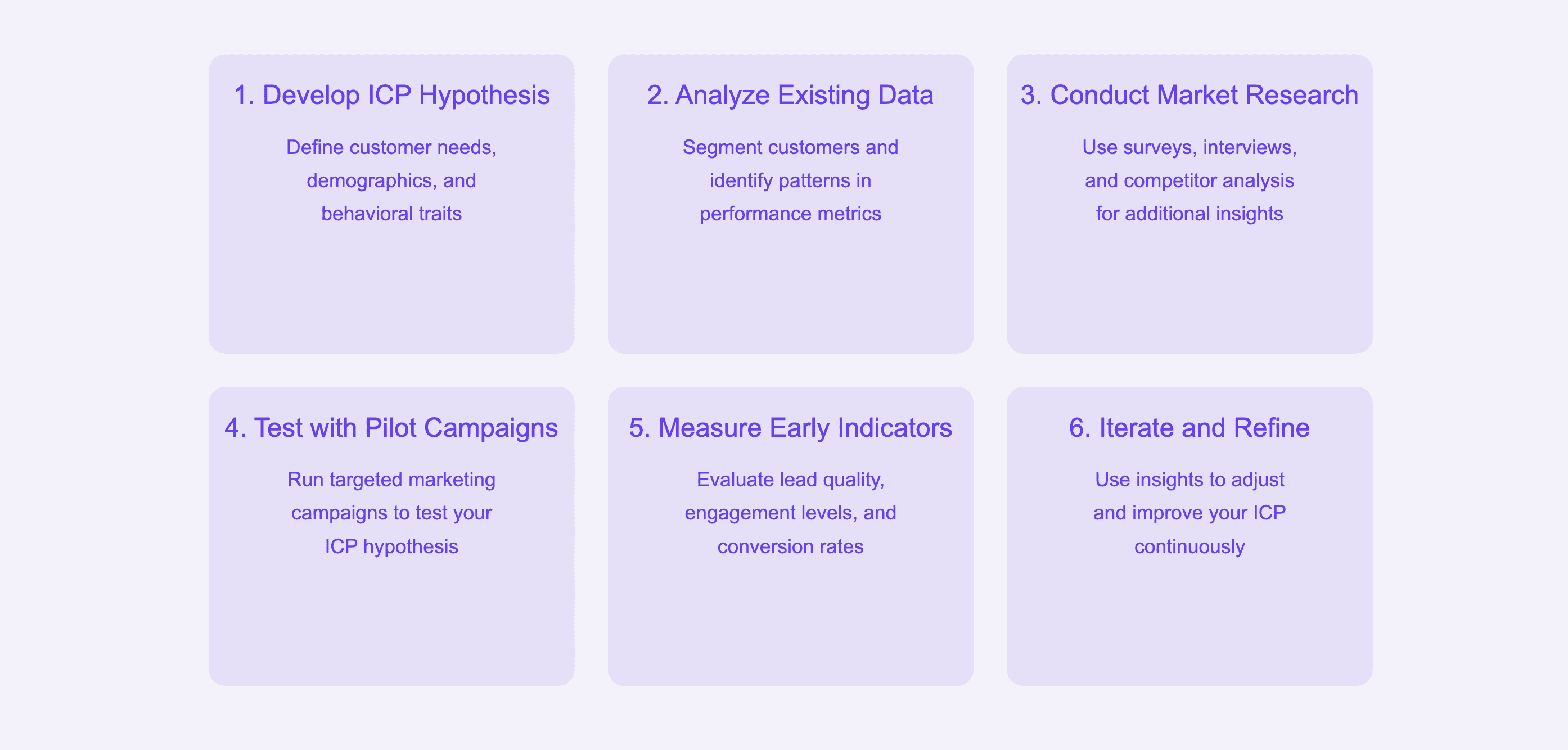
6 Steps to Validate Your ICP Hypothesis

by
Wiktoria Slowikowska
Sep 10, 2024
Identify and convert your most valuable users
Sign Up

Imagine this: You launch your startup's new campaign, but it doesn't work out as planned. Why? Your guess about who your ideal customer is might be off. In the startup world, knowing exactly who your perfect customer is can make or break your success. It helps you market better and grow faster.
But here's the thing: Just guessing who your ideal customer is isn't enough. You need to check if your guess is right. That's where this blog comes in. We're going to show you six simple steps to test your ideal customer profile and make your marketing work better.

Step 1: Develop Your ICP Hypothesis
Before you can validate anything, you need a solid hypothesis about who your ideal customer is. Start by defining:
Customer Needs: What problems does your product or service solve?
Demographic Information: Who experiences these problems? Consider factors like industry, company size, job roles, and location.
Behavioral Traits: How does your ideal customer prefer to engage with solutions similar to yours?
For instance, if you’re developing a cybersecurity solution, your hypothesis might be that mid-sized tech companies with a high need for data protection are your ideal customers.
Step 2: Analyze Existing Customer Data
Utilize any existing customer data to test the validity of your ICP hypothesis. Here’s how:
Customer Segmentation: Segment your current customer base by characteristics like industry, company size, and geographic location.
Performance Metrics: Identify which segments have shown the highest engagement, satisfaction, and revenue generation.
Feedback Analysis: Look at feedback, support tickets, and product usage patterns to understand common traits among your best customers.
This data helps you identify patterns and validate whether your initial ICP hypothesis matches your current successful customers.
Step 3: Conduct Targeted Market Research
Conducting market research provides additional insights and validation for your ICP hypothesis. Focus on:
Surveys: Distribute surveys to potential customers to gauge their pain points, needs, and how they currently address these issues.
Interviews: Hold interviews with individuals from your target segments to delve deeper into their challenges and preferences.
Competitor Analysis: Analyze your competitors' customer bases to understand which segments they are targeting and how your offering differs.
Market research helps you understand if your ICP aligns with broader market needs and customer preferences.
Step 4: Test Your ICP with Pilot Campaigns
Put your ICP hypothesis to the test by running targeted marketing campaigns:
Ad Campaigns: Use platforms like LinkedIn and Google Ads to run campaigns specifically targeting your hypothesized ICP. Measure click-through rates, conversion rates, and lead quality.
Content Marketing: Create content that addresses the specific needs and interests of your ICP. Track engagement metrics such as downloads, shares, and comments.
Pilot campaigns provide practical data on whether your messaging and targeting resonate with your ideal customers.
Step 5: Measure Early Indicators
Evaluate the performance of your pilot campaigns to gauge the accuracy of your ICP:
Lead Quality: Assess the quality of leads generated from your campaigns. Are they fitting your desired customer profile
Engagement Levels: Analyze how prospects interact with your content and messaging. High engagement often indicates alignment with your ICP.
Conversion Rates: Track the conversion rates from leads to customers. A high conversion rate suggests that your ICP is likely accurate.
Early indicators help you understand how well your ICP hypothesis translates into actual customer behavior and interest.
Step 6: Iterate and Refine
Validating your ICP is an ongoing process. Use insights from your pilot campaigns and early indicators to refine your ICP:
Feedback Loops: Gather feedback from your sales and customer success teams. They can provide insights into how well the ICP aligns with real customer interactions.
Adjustments: Make necessary adjustments to your ICP based on data and feedback. This might involve tweaking demographic details, behavioral traits, or industry focus.
Continuous Monitoring: Regularly review performance metrics and customer feedback to ensure that your ICP remains relevant and accurate.
Iterative refinement ensures that your ICP evolves with market changes and continues to guide effective marketing and sales strategies.
Conclusion
Validating your ICP hypothesis is essential for aligning your startup’s strategies with real customer needs and behaviors. By following these six steps—developing your ICP hypothesis, analyzing existing customer data, conducting market research, testing with pilot campaigns, measuring early indicators, and iterating—you can ensure that your ICP is well-founded and actionable. This validation process not only improves your targeting but also enhances your overall marketing and sales effectiveness, setting the stage for sustainable growth and success.




